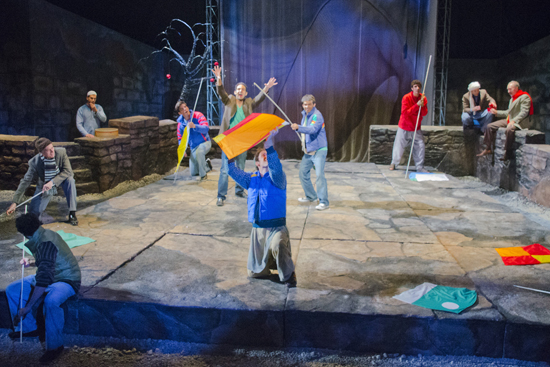New Rep Brings Vivid Kite Runner to Stage
BU faculty, alums lead in adaptation of best seller

Luke Murtha as Afghan youth Hassan (center, front) and Fahim Hamid (CFA’11) as Amir (center, back) run their kite in the tournament scene of Matthew Spangler’s stage adaptation of Khaled Hosseini’s The Kite Runner. Photo by Andrew Brilliant
Drawing on sources as varied as Hazara YouTube videos and Pashtun and Tajik speech archives, Christine Hamel immersed herself in the sounds and mannerisms of Afghanistan to coach actors in the New Repertory Theatre’s current production, The Kite Runner, an adaptation of Khaled Hosseini’s vivid best-selling novel.
A College of Fine Arts assistant professor of voice and speech, Hamel (CFA’05) is one of a dozen BU faculty and students in the cast and crew of the ambitious Matthew Spangler play, which bridges two distant worlds through the memory of Amir, an émigré who returns to Afghanistan to right a wrong he committed in his youth in Kabul. The play is running through September 30 at the Arsenal Center for the Arts.
Like the best-selling novel on which it is based, The Kite Runner is a boldly woven, at times disturbing tale of a young Afghani, spanning from 1970s Kabul to southern California nearly 40 years later. The play was written in collaboration with Hosseini, whose 2003 novel spent five years on the New York Times best-seller list, has been published in 42 languages, and was turned into a film directed by Marc Foster. “The play is a very beautiful and faithful adaptation,” says director Elaine Vaan Hogue (CFA’97), a CFA assistant professor of acting and directing and head of theater arts.
The production “sets a tone of adventurousness” that has become a hallmark of the New Rep, says Jim Petosa, director of the CFA School of Theatre and recently named artistic director of the nearly three-decade-old Watertown-based company. Much like the BU-affiliated Huntington Theatre Company, the New Rep promises to be a fertile source of professional opportunities for BU alumni and students, Petosa says, from actors to musicians to designers.
The play paints an all-encompassing picture of 1970s Kabul—“the colors, smells, the vibrancy, and richness” of life before the Soviet invasion, says Vaan Hogue, whose extensive directing credits include Walking the Volcano at the Boston Playwrights’ Theatre and CFA’s production last spring of Execution of Justice. With dialogue and narration pulled largely from the novel, The Kite Runner evokes the worlds of protagonist Amir with music—including a live performance of a boxed-shaped percussion instrument called a cajón—and a rock and gravel set designed by Paul Tate dePoo III (CFA’10). “It’s part of the landscape of Afghanistan, but it’s like our playground,” says Vaan Hogue. The impressionistic set “can become any place,” including California, the home of the adult Amir, where much of the play is set.
And there are kites, handcrafted for the production, with the story’s pivotal kite tournament re-created in a blazing spectrum of colors. Carried throughout the play is Amir’s iconic blue kite, the one that falls almost magically into the hands of Amir’s friend Hassan in a pivotal moment in the story. The actors will work the kites like puppets, by undulating the flexible fiberglass handles, says Vaan Hogue.

Then there are the accents required by the actors. While the film version relied on subtitles for the Kabul scenes, that wasn’t an option for the stage adaption, Hamel says. She aspires not to scholarly precision—accents uncommon to the stage require crash courses—but to a kind of fluency. “It is not so much about authenticity as it is about making artistic choices” to clearly convey distinctions between the characters, she says, and to “build a world that is consistent and noninvasive to the storytelling.” To do that she had to research the different dialects of Dari, the Persian mother tongue of a nation that’s a volatile mosaic of ethnic groups with their own colloquial tongues. “The Hazara speak a little higher in resonance, a little sing-song, while the Pashtun speak in a tone that’s low, more consistent, and slightly more formal,” she says. The actor, singer, and voice coach’s many stage credits include her appearance as Laura in The Glass Menagerie, the inaugural production for the Boston Center for American Performance (BCAP), the professional extension of the School of Theatre.
Hamel worked individually with actors early in rehearsals, coaching them on how to breathe, punctuate sentences, and move their hands and arms in addition to coaxing sounds from their throats in unfamiliar ways. She is a virtual Henry Higgins of stage accents, with a schooled ear for vocal nuance. A rigorous researcher, she’s learned that native dialects often reflect topography and climate. “People with big expansive gestures, big open vowels, probably live somewhere warm, while those with tighter gestures and tighter jaws probably live somewhere cold,” she says.
For CFA lecturer Rob Najarian, who performs several roles in the play and is “violence coordinator”—or fight coach—for the fight scenes, the challenge was to adapt the distinct but subtle differences between his characters’ accents. “It can trip you up,” says Najarian. But the actors describe a point where the accents click in and begin to feel natural. “The word we use is assimilation,” says Petosa. “You work very hard, but once you’ve assimilated” that accent, or mannerism, “you own it so that you don’t have to work it. You trust it.” For his role as the sociopathic Assef, the man Amir witnesses raping his gentle companion Hassan, John Zdrojeski (CFA’12) not only worked to develop the character’s Pashtun accent, but read up on serial killer Ted Bundy, who like the Taliban Assef could be as charming as he was diabolical.
The play swirls around Amir’s remembering, and “in the theater the act of remembering is a very visceral, very in-the-moment thing,” says Vaan Hogue of the central character, portrayed on stage as a boy by Fahim Hamid (CFA’11). “As Amir travels deeper and deeper into his memory, he’s bringing to life all the people in his past and present, and the telling of this story to the audience is the only way he can find redemption.”
For his part, Hamid has to embrace a Pashtun accent as well as affect the physical bearing of a child. “I play Amir until he’s 13,” says Hamid, who read the novel in high school and was blown away by it. “I run around a lot.”

The cast also includes Ken Baltin, as Baba, and Paige Clark (CFA’09), as Soraya. Baltin is familiar to New Rep audiences for performances in such plays as Waiting for Godot and American Buffalo.
Both the playwright, who met with the cast on a recent visit to the East Coast, and Vaan Hogue point out that The Kite Runner dispels the stereotype of Afghanistan as a war-torn land of poverty and terrorists. By inquiring at a local Afghan restaurant, Vaan Hogue found her way to Najim Azadzo, a Watertown architect who has attended rehearsals and made himself available to answer cast members’ questions. “He’s a Pashtun refugee whose story parallels Amir’s in a sense,” she says. “In the 1980s he walked to Pakistan across mountain passes.”
But Amir’s is also a universal story about loss of innocence, and its characters “provide a humane and moral compass for us all,” Vaan Hogue says. “The universality of Amir’s story overcomes cultural barriers…it is impossible to be unmoved by the experience of this story.”
The Kite Runner runs through September 30 at the Charles Mosesian Theater at the Arsenal Center for the Arts, 321 Arsenal St., Watertown. Tickets range from $28 to $58, with a $7 discount for seniors and $20 tickets for full-time students with ID; $15 student rush tickets are available 30 minutes before curtain time, subject to availability. Parking is free in the Arsenal garage. Purchase tickets here or call 617-923-8487 for more information.
Comments & Discussion
Boston University moderates comments to facilitate an informed, substantive, civil conversation. Abusive, profane, self-promotional, misleading, incoherent or off-topic comments will be rejected. Moderators are staffed during regular business hours (EST) and can only accept comments written in English. Statistics or facts must include a citation or a link to the citation.